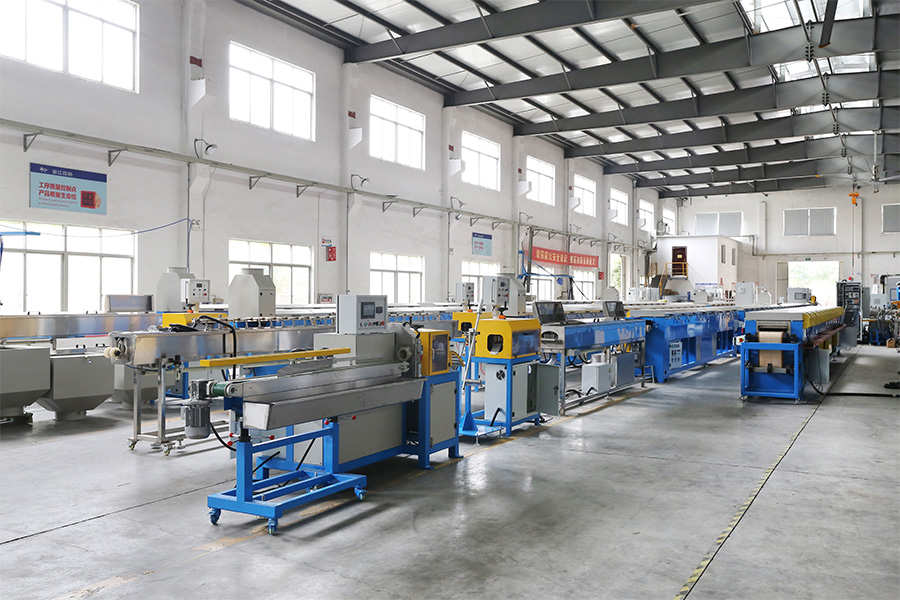The Complete Rubber Extrusion Production Line: Key Components and Their Functions
The rubber extrusion production line plays a crucial role in modern manufacturing, particularly in industries that require the production of rubber products, such as automotive components, seals, gaskets, hoses, and many others. A rubber extrusion line is an integrated system that processes raw rubber into a desired shape by applying heat, pressure, and shear forces. The line consists of several components working in harmony to ensure smooth, efficient, and consistent production.

The rubber mixer is the crucial component in the rubber extrusion production line. Its primary role is to blend raw rubber, additives, and other compounds into a homogenous mixture. The rubber mixture typically includes various ingredients such as fillers, accelerators, anti-aging agents, vulcanizing agents, and colorants. These materials are combined to create a specific rubber formulation tailored to the desired end product.
There are different types of rubber mixers, with the internal mixer being the common. This type of mixer uses a pair of counter-rotating blades to mix the ingredients under heat and pressure. The quality of the mix has a significant impact on the final product's performance, such as its strength, elasticity, and durability.
The mixer is often followed by a cooling system to bring the temperature of the rubber compound down, making it ready for extrusion.
The rubber extruder is the heart of the rubber extrusion production line. It takes the rubber compound prepared by the mixer and forces it through a die to form a continuous shape. The extruder works by applying heat and pressure to the rubber, which causes it to flow and take the shape of the die opening.
There are various types of extruders used in rubber processing, but the two common are the single-screw extruder and the twin-screw extruder. The single-screw extruder is widely used for simpler rubber formulations, while the twin-screw extruder offers more control over the processing of complex rubber compounds.
The rubber extruder machine is designed to achieve mixing, heating, and shear forces, ensuring that the rubber is uniformly processed and that the desired product dimensions are achieved.
The extrusion die is a critical component in determining the shape and dimensions of the rubber product. It is attached to the end of the extruder, and its role is to shape the rubber compound into the desired form as it exits the extruder. Dies can be custom-designed to produce various profiles, such as hoses, seals, gaskets, and strips, depending on the specific application.
The die is typically made from high-quality steel or other durable materials that can withstand the heat and pressure exerted by the extruder. Die design is a highly specialized field, as the size and shape of the die opening directly influence the consistency and quality of the final product. Proper die design is essential for ensuring minimal defects and ensuring that the rubber product meets the required specifications.
Once the rubber has been extruded into the desired shape, it needs to be cooled to maintain its structural integrity. The cooling system is responsible for controlling the temperature of the extruded rubber, which is crucial for maintaining its physical properties and preventing deformation.
Cooling is typically achieved through the use of water tanks, air cooling units, or a combination of both. The cooling process ensures that the rubber solidifies properly and retains its dimensions. In some cases, the cooling process is accompanied by a stretching or pulling mechanism that helps maintain the uniformity of the extruded product.
Cooling is also important for preventing overheating, which could affect the rubber's molecular structure and compromise its mechanical properties. The cooling system helps in stabilizing the product and preparing it for further processing.
The puller or haul-off system is designed to pull the extruded rubber at a controlled speed, ensuring that it does not stretch, deform, or become misaligned. This system is typically installed downstream from the cooling zone. It works by gripping the extruded product and pulling it at a constant speed to maintain uniformity in the final length of the rubber product.
The speed of the puller is carefully synchronized with the extrusion process to prevent issues such as stretching or sagging. In high-speed production lines, it is essential to ensure that the puller is capable of maintaining consistent tension on the product. If tension is not adequately controlled, defects like uneven thickness or misalignment may occur.






 English
English 中文简体
中文简体 русский
русский



